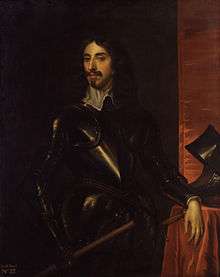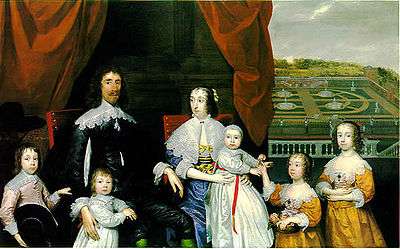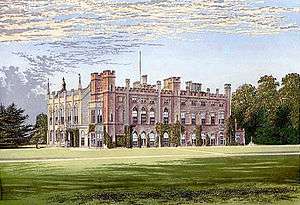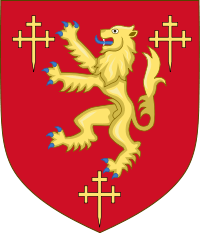Arthur Capell, 1st Baron Capell of Hadham
Arthur Capell, 1st Baron Capell[2] (20 February 1608 – 9 March 1649), of Hadham Hall and Cassiobury House, Watford, both in Hertfordshire, was an English politician who sat in the House of Commons from 1640 until 1641 when he was raised to the peerage as Baron Capell. He supported the Royalist cause in the Civil War and was executed on the orders of parliament in 1649.
The Lord Capell of Hadham | |
|---|---|
 Portrait by Henry Paert the Elder | |
| Member of Parliament for Hertfordshire | |
| In office 1640–1641 | |
| Monarch | Charles I |
| Personal details | |
| Born | 20 February 1608 Hadham Hall, Hertfordshire |
| Died | 9 March 1649 (aged 41) Old Palace Yard, Palace of Westminster, London |
| Nationality | English |
| Spouse(s) | Elizabeth Morrison |
| Relations |
|
| Children |
|
| Alma mater | Queens' College, Cambridge |
| Occupation | Royalist army officer and Member of Parliament |
| Military service | |
| Allegiance | Royalist |
| Rank | Lieutenant-General |
| Battles/wars | English Civil War |
Life
Capell was the only son of Sir Henry Capell, of Rayne Hall, Essex, and his wife Theodosia Montagu, daughter of Sir Edward Montagu of Boughton House, Northamptonshire.[3] He was educated at Queens' College, Cambridge.[4] In April 1640, he was elected Member of Parliament for Hertfordshire in the Short Parliament, and was re-elected MP for Hertfordshire for the Long Parliament in November 1640.[3][5][6] At first, he supported the opposition of the arbitrary government of King Charles I of England. On 5 December 1640, he delivered the "Petition from the county of Hertfordshire", outlining grievances against the King,[6] and continued to criticise the King and the Kings advisers right through to the summer of 1641.[7] In June 1641, in an effort to raise additional revenue, the price of baronies was reduced from £400 to £350,[8] and Arthur Capell was raised to the peerage by the title of Baron Capell of Hadham, in the County of Hertford, on 6 August 1641.[3][8] However, Capell was openly allying himself with the King's cause by early 1642,[8] on which side his sympathies were now engaged.
On the outbreak of the English Civil War, he was appointed lieutenant-general of Shropshire, Cheshire, and North Wales, where he rendered useful military services, and was later made one of the Councillors of Prince Charles Stewart (who later became King Charles II of England), as well as a commissioner at the Treaty of Uxbridge in 1645. He attended the Queen, Henrietta Maria of France (the wife of King Charles I), in her flight to France in 1646, but disapproved of her son Prince Charles's journey thither, and afterwards retired to Jersey; later, he subsequently aided in the King's escape to the Isle of Wight.[3]
Capell was one of the chief Royalist leaders in the second Civil War, but met with no success, and on the 27 August 1648, together with Earl of Norwich, he surrendered to Lord Fairfax at Colchester, on the promise of quarter for life.[9] This assurance was afterwards interpreted as not binding the civil authorities, and his fate for some time hung in the balance. He succeeded in escaping from the Tower of London, wading the moat once he had got over the walls, only to be betrayed by a Thames waterman, who had been engaged to row him from a hiding place at the Temple to one in Lambeth. He was again captured and was condemned to death by parliament, on 8 March 1649,[3][10] and beheaded together with the Duke of Hamilton and the Earl of Holland.[3]
One of Lord Capell's last requests was for his heart to be buried with the body of King Charles I, and after his execution, Capell's heart was preserved in a silver box.[11][3] The silver box was kept in the custody of the Bishop of Winchester, and was later presented, by the Bishop, to King Charles II. In 1703, a heart in a silver box was found at Hadham Hall, suggesting that the King sent the heart to Capell's son. It was later taken to Cassiobury, but since the dissolution and sale of the Cassiobury estate, the whereabouts of Capell's heart are now unknown. A memorial stone to Lord Capell was erected at St Cecelia's Church in Little Hadham, Hertfordshire.[11]
Works
Capell wrote Daily Observations or Meditations: Divine, Morall, published with some of his letters in 1654, and reprinted, with a short life of the author, under the title Excellent Contemplations, in 1683.
Marriage and children


On 28 November 1627, Capell married Elizabeth Morrison, daughter and sole heiress of Sir Charles Morrison of Cassiobury, Hertfordshire, and Mary Hicks, who brought the Cassiobury estate, including Cassiobury House, into his family, making him one of the richest men in England. His lands were scattered across ten counties, and brought him a reputed annual income of £7,000. By his wife, he had four daughters and five sons, including:
- Anne Capell, wife of John Strangways, MP.
- Mary Capell (1630-1715), wife of Henry Somerset, 1st Duke of Beaufort.
- Arthur Capell, 1st Earl of Essex (1631-1683), eldest son and heir, created Earl of Essex at the Restoration. When the Earl, facing charges of treason, committed suicide in 1683, King Charles II remarked that he should have known his life would be spared, for "his father died for mine".
- Elizabeth Capell (1633-1678), wife of Charles Dormer, 2nd Earl of Carnarvon.
- Henry Capell, 1st Baron Capell of Tewkesbury (1638-1696), a politician and founder of the Royal Botanic Gardens at Kew.
- Charles Capell (died 1657)
- Theodosia Capell (died 1661), wife of Henry Hyde, 2nd Earl of Clarendon.
Notes
- Montague-Smith 1968, p. 430.
- The variant spelling "Capel" is frequent in the historical sources.
- Chisholm 1911, p. 249.
- "Capell, Arthur (CPL618A)". A Cambridge Alumni Database. University of Cambridge.
- Willis 1750, p. 232,242.
- Hazell 1987, p. 5.
- Hazell 1987, p. 6.
- Hazell 1987, p. 7.
- Chisholm 1911, p. 249 cites S. R. Gardiner History of the Civil War, iv, 206; also article on Thomas Fairfax by C.H. Firth in the Dictionary of National Biography.
- Hutton 2006.
- "A Brief History of Little Hadham". The Hadhams. Retrieved 1 November 2014.
References
- Hazell, Martin (1987). Fidelity & Fortitude: Lord Capell, his regiments and the English Civil War. Partizan Press. ISBN 0-946525-36-6.CS1 maint: ref=harv (link)
- Hutton, Ronald (October 2006) [2004]. "Capel, Arthur, first Baron Capel of Hadham (1604–1649)". Oxford Dictionary of National Biography (online ed.). Oxford University Press. doi:10.1093/ref:odnb/4583. (Subscription or UK public library membership required.) The first edition of this text is available at Wikisource: Stephen, Leslie, ed. (1887). . Dictionary of National Biography. 9. London: Smith, Elder & Co.
- Montague-Smith, P.W., ed. (1968). Debrett's Peerage, Baronetage, Knightage and Companionage. Kingston-upon-Thames: Kelly's Directories. p. 430.CS1 maint: ref=harv (link)
- Willis, Browne (1750). Notitia Parliamentaria, Part II: A Series or Lists of the Representatives in the several Parliaments held from the Reformation 1541, to the Restoration 1660 ... London. pp. 229, 232, 240, 242.CS1 maint: ref=harv (link)
Attribution:

Further reading

- Lundy, Darryl. "Arthur Capell, 1st Baron Capell of Hadham". thepeerage.com.
| Parliament of England | ||
|---|---|---|
| Preceded by Parliament suspended since 1629 |
Member of Parliament for Hertfordshire 1640–1641 With: Sir William Lytton |
Succeeded by Sir William Lytton Sir Thomas Dacres |
| Peerage of England | ||
| Preceded by New Creation |
Baron Capell of Hadham 1641–1649 |
Succeeded by Arthur Capell |
